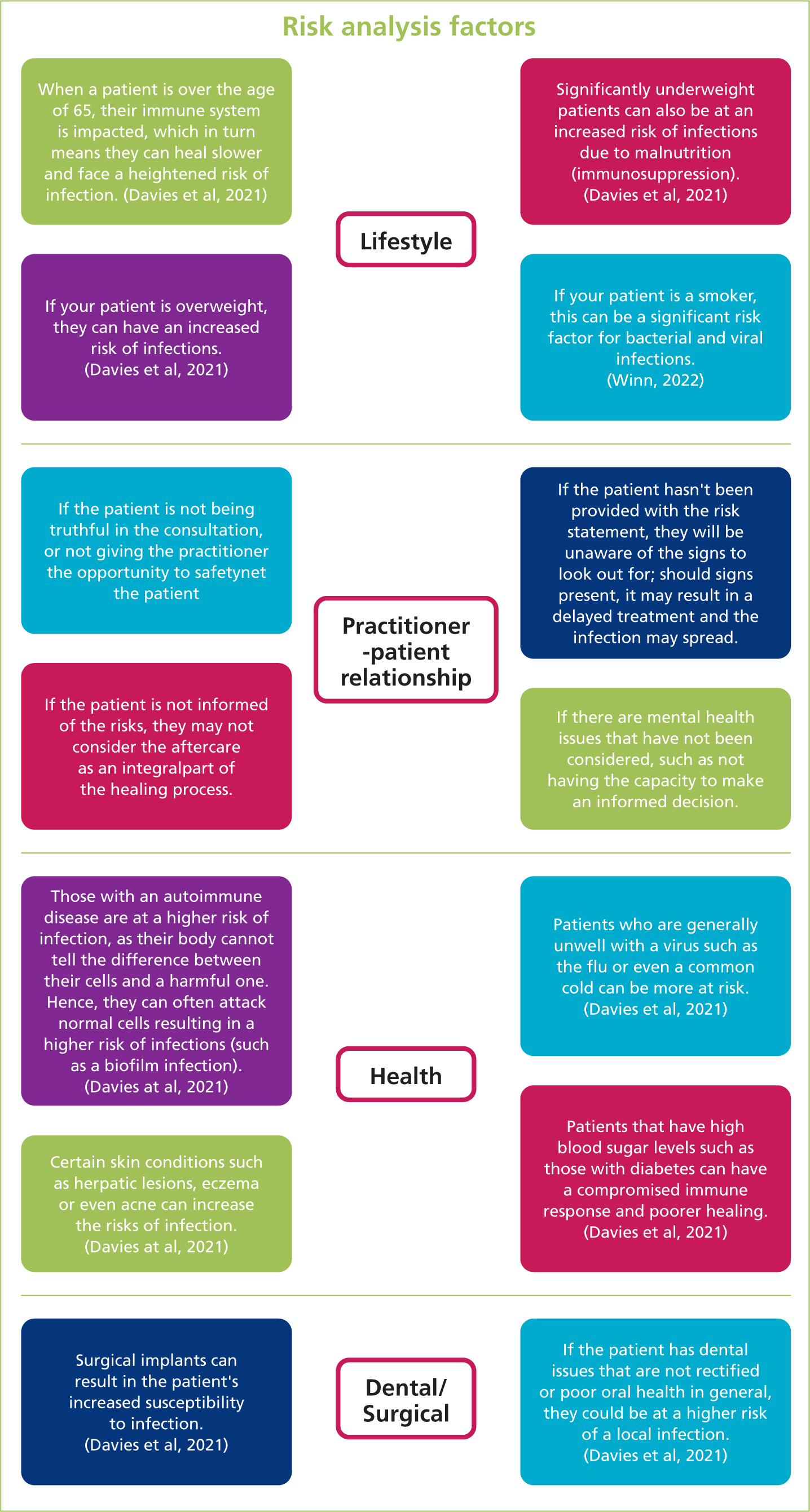

As a clinical professional, a director, and leading injector of an aesthetics clinic in the Southeast (in the process of getting licenced under the Care Quality Commission (CQC)), I wonder where the benchmark has gone.
We all know complications are real, and although we often see the emotional images of a vascular occlusion cascade our social media platforms, we hear very little about its less engaging friend—bacterial infections. Non-surgical treatments are on the rise, the industry is still unregulated, and we still lack standardised licenses for premises. The level of complications is rising as a result (Baker, 2018). However poorly they may be reported, the presence is real.
As medical professionals, we are aware of threats to our patients that can be brought far away from our clinic rooms: antibiotic resistance and skin infections. It is clearer than ever that prevention deserves to be an area of focus. Therefore, in this article I will discuss four pillars of prevention:
1.
The practitioner
It seems like common sense, but the practitioner can act as an infection threat if they themselves are not adhering to the fundamentals of healthcare protocols. Instagram has made the industry glamorous with many injectors adorning their clinic rooms with styled hair, catwalk-worthy outfits, glamorous make-up, and nail extensions that demand attention. The difficulty comes when we try to define the nature of the profession—within that blurred boundary and lack of clarity allows the grey area we are currently all swimming in chaotically, passing each other like a dual carriage way into clown land.
But let's dig deeper. What do we know? We know that in cases where the skin integrity is breached, it is pertinent to follow local and national guidelines in order to mitigate the risks of infection (Davies et al, 2021). The contamination process occurs more often at the point of treatment. Considering this risk, it is unsurprising from the guidelines that the practitioner themself has a checklist to meet: hair must be tied back, watches must not be worn, jewellery must be limited to a single wedding band, shoes must be close-toed, and make-up must be minimal.
At the moment there is a lack of regulation, but with the winds of change looming, we hear whispers and action related to a licence regarding premises. Although many are focusing on the location of sinks and heat-welded flooring that may need to be installed, it is also important that practitioners understand that this may also extend to how the practitioner presents themself.
As an aesthetic nurse who works only in a private clinic owned by herself, I have that voice in my head screaming, ‘you're not in the NHS now, this is your own business and surely you can wear what you want’. But I choose to follow the guidelines because I accept that what we do falls into the category of a healthcare profession—a clinical profession where patient safety underpins everything we do. With that, comes responsibility.

2.
The area of treatment (environment)
The topic of premises is a popular narrative at the moment, with many assessing what this new licence will look like, and many under the impression that it will loosely follow the remits of a CQC licence. However, only time will tell.
The focus for the purposes of this article is to focus on how your environment can act as a breeding ground for infections, so let us take a deeper look at that. The Aesthetic Complication Expert Group (ACE) guidelines stipulate that certain pathogens can survive on clinical surfaces for significant time frames. The Straphylococcus aureus lingers for 7 days to 7 months and several studies have documented significant links between Straphylococcus aureus and dermal fillers. Thereby, if we are not adhering to strict guidelines, we are adding to the risk profile.
At my Kent-based clinic, we have strict infection control guidelines in place, with these extending to (but are not limited to) hand-washing observations and checks, environmental checks, cleaning logs and necessary audits. Through inductions, we ensure all staff understand their responsibilities with regard to the environment into which they are inviting patients. Implementing strict cleaning guidelines before, between, and after patients is also paramount in the avoidance of unnecessary infections (ACE, 2020). This includes every surface a patient may touch, such as the handles, work surfaces, beds, and mirrors. In regard to the room itself, each clinical room has a suitable hand washing sink, with non-touch soap dispensers and disposable paper hand towels. The flooring is a hard surface with no cracks or gaps for bacteria to harbour and the floor should be washable. The bin for sharps is off the floor with an appropriate waste bin and clinical waste bin in the area. As nice as a fluffy pillow or a fleecy blanket may feel, if the procedure compromises the integrity of the skin, these items will only compromise your safety measures.

3.
The patient
One of the concerns that populate the industry is this production line mentality, and the inadequacy of consultations. There are many red flags when consulting with patients and in particular certain risk factors can make your patient more likely to face increased infection risks. It is important to assess your patients to ensure you are not missing the opportunity to safety net them from potential increased risk of infection.
4.
The product
As a medical practitioner we have all shuddered when we see treatments being cascaded over Instagram where the patients skin has been prepared for a treatment using a baby wipe, cotton buds with tap water or even more shockingly when the make-up is left on, or better still when there has been a tiny area cleaned and the surrounding areas are still caked in ten inches of double wear as are the practitioners gloves as they conduct the treatment.
Therefore, before we talk about how we prepare the skin, we should take a moment to understand the bacteria that can live in our makeup supplies. There has been several studies that describe how much bacteria lives in our makeup and cause illness such as vaginosis, gastroenteritis and respiratory tract infections to name a few (Cosmetic Business, 2015). A study that shown that make up can test positive for deadly strains of bacteria and in fact in one study Enterococcus faecalis was found,: this bacteria can cause meningitis and septicaemia (Cosmetic Business, 2015) and with that bombshell, the inappropriateness of practitioners treating patients with make up becomes clearer than ever.
Prior to treating a patient, it is key to follow the guidelines when preparing the area of treatment to reduce microorganism levels. This related to what we use to prepare the skin as well as the amount of tissue that is cleaned, as most acute infections arise from the patient's own bacteria contaminating the site at the time of treatment (ACE, 2020).
Prior to treatment it is also recommended to treat the skin with 0.5% Chlorhexidine in 70% alcohol solution, as this is licensed for minor surgery skin preparation. This can, however, irritate the eyes and respiratory tract and has also been linked to allergies (ACE, 2020). The complications in medical aesthetic collaborative do not recommend the use of alcohol alone as an adequate skin preparation due to the lack of residual protection, yet using a product such as Clinisept + (Hypochlorous acid) can swiftly inactivate bacteria, spores, and viruses. This comes with the extra benefit of being less inflammatory, less irritating to the eyes and respiratory tract, and being widely bio-compatible (ACE, 2020). Guidelines advocate the use of hypochlorous acid within aesthetic medicine due to the fact there is no potential for microbial resistance to build (ACE, 2020).
The aesthetics industry may be a baby in relation to its dominating cousins, but one thing remains certain—it is a force to be reckoned with. For those of us who are lucky enough to be a part of this incredible industry, we must take responsibility as our patients deserve the best care they can receive. Within aesthetic practice there are some practices that aren't regulated, and this should be avoided if we are going to support patients in the long run and avoid antibiotic resistance. Therefore, for patient safety, it is pertinent to avoid complications by adopting robust infection control measures and strict guidelines (Baker, 2018).



